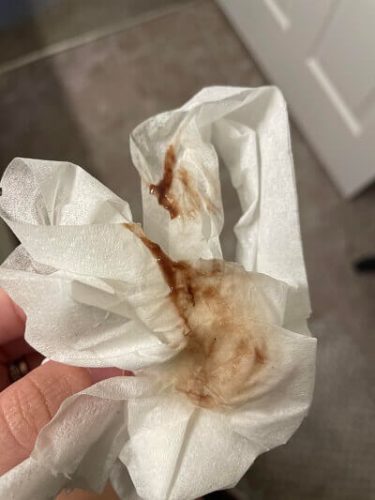According to our research conducted with more than a thousand women, 24% of users have already experienced brown discharge accompanied by a bad smell and/or burning sensation. And 36% of participants said they have had breakthrough bleeding while using contraceptives.
This research is important because it proves that a good portion of women have already gone through this: that brown discharge in your underwear that shows up even when you’re not expecting your period. Sometimes it appears as just a brownish tinge mixed with normal mucus, other times it’s thick and dark like coffee grounds. It’s hard not to wonder: what does this brown discharge mean?


Those who want to get pregnant, or even those who don’t but suspect the possibility, might have this doubt. After all, can brown discharge indicate that a woman is pregnant? What should you do when this possibility exists and the brownish secretion appears for more than two days in a small amount?
To solve these dilemmas, let’s understand a little about our bodies. This will help avoid stress and unnecessary expectations near the end of the cycle. First of all, understanding the difference between discharge and mucus secretion is essential.
Difference Between Discharge and Mucus Secretion
Normally, discharge is something bad, possibly stemming from sexually transmitted infections (STIs) or some intimate disease1. That’s why the correct term is mucus secretion, which is normal for a healthy body. If brown discharge is accompanied by burning or a bad smell, you should seek medical help immediately, as it may be one of the signs of cervical cancer.
The body is a complex machine, and hormones control everything when it comes to fertility. They can fluctuate a lot between cycles, causing momentary hormonal changes due to these constant shifts2. That’s why brown spotting and discharge can happen and do not necessarily mean a woman is pregnant.
Perhaps it’s a discharge darker than usual, sometimes with the appearance of coffee grounds or a yellowish tint. But when it occurs, it means there’s a small amount of blood mixed in.
This brown discharge could be a sign of pregnancy, but there are also other possibilities, such as breakthrough due to low hormone levels (progesterone), ovulation bleeding, start of menstruation, withdrawal bleeding, or bleeding induced by morning-after pills.
If you have doubts, it is essential to see a medical specialist to get the correct diagnosis and learn about the treatments. If you’re pregnant, prenatal care should be started, as brown discharge can indicate an ectopic pregnancy.
Can Brown Discharge Mean Pregnancy? Not Always…
Brown vaginal discharge is considered a common occurrence in a woman’s life3, but it isn’t always caused by natural factors. In some cases, this dark discharge may indicate infections, such as bacterial vaginosis and pelvic inflammatory disease.
This is rarely discussed, but most cases of chronic discharge are actually caused by the use of latex condoms. Because the vaginal mucosa is so sensitive, it can develop allergic reactions to the condom material, which can disrupt the vagina’s natural pH, creating the perfect environment for the growth of bacteria that cause genital tract infections.
Another common factor, which many women believe is beneficial but actually harms health, is the so-called “little shower.” Its use produces such a deep cleaning of the vaginal area that it strips away all of the area’s natural protection. This alters the quality of the vaginal flora and allows invasive bacteria in. The result is infections and, automatically, the presence of secretion4.
Frequent use of intimate soaps or strongly scented soaps, as well as moisturizers, vaginal creams and lubricants that make sexual contact easier, especially those with flavors and scents, pose a great risk to vaginal health. They also disturb the balance of the vaginal flora and natural pH.

Pay attention to the symptoms. If the brown discharge comes with a bad smell, burning while urinating, itching and swelling in the area, and persists for more than a few days, you should see your doctor. They will recommend the best treatment.
If there’s a hormonal deficiency, brown discharge happens because there isn’t enough progesterone. That means the endometrium will develop differently, with more involvement of estrogen, and the little progesterone will give this blood a darker appearance.
The structure of the endometrium and the characteristics of the blood will be different from a cycle with two correct hormonal phases, estrogen in the ovulation phase and progesterone after ovulation. Light brown discharge may indicate pregnancy if this flow is not heavy, even if there are brownish clots. This brownish mucus may be evidence of possible implantation.
Ovulation Bleeding
Ovulation bleeding can also confuse women trying to conceive or avoid pregnancy. Normally, it tends to happen in the middle of the cycle. But since late ovulation is possible, it can also happen toward the end of the cycle, or when you’re already expecting your period. Of course, all this depends on each woman’s menstrual cycle, since some have irregular periods.
This bleeding may be brownish or look like thin blood, similar to stretchy mucus. It may raise suspicion, but still does not mean the woman is pregnant.
The best way to know what stage of the cycle you are in is to keep detailed track. In the past, women used period tracking calendars. Today, you can use a simple cell phone app that tracks your cycle with the information you provide.
For complete tracking, you can use ovulation tests that show you if ovulation is approaching, occurring, or has already passed. For this, we recommend the ovulation test by Famivita.
Start of Menstruation
The beginning of your period may also be brown! Some women have this kind of flow for a few days before or after heavier red bleeding5. Considered perfectly normal by doctors, it can arrive slowly and leave those trying to conceive in doubt.
That’s why it’s always best to wait a few days to see if the flow increases gradually or suddenly, indicating your actual period. Brown discharge may be a symptom of pregnancy when this red or brown flow isn’t heavy. In this case, you should consider the possibility of being pregnant.
Morning-After Pill
The morning-after pill (MAP) is the queen of brown discharges! Do you know why? It raises progesterone levels to prevent pregnancy. This ends up triggering an early period.
This commonly happens after taking the morning-after pill and confuses many women who use MAP as an emergency method after unprotected sex, causing brown discharge before your period actually arrives! I took the morning-after pill, had brown discharge, am I pregnant? Not always! In fact, it is recommended that you take a pregnancy test if your normal period doesn’t come after using the pill.

Don’t take the test in the days that follow, but wait for your next cycle. The efficacy of this pill is not the best, and pregnancy can occur. The same goes for contraceptives. Just as with the morning-after pill, these brown breakthroughs may happen when you stop using it.
Finally, we can say that yes, brown discharge can be a sign of pregnancy in the near future. This is due to implantation bleeding, which can occur as soon as the baby attaches to the mother’s endometrium. However, this light brown discharge is the exception, not the rule.
Most pregnancies occur without any apparent implantation or bleeding. If you suspect pregnancy, it’s best to wait and see the intensity and duration of this flow, as not all bleeding is implantation bleeding. Before assuming this, consider the previous possibilities and, of course, wait for the right time to take a test.
Readers’ Questions:
Can brown discharge be a sign of problems?
Besides the reasons we’ve mentioned, brown discharge often indicates a lack of progesterone. If this happens to you only occasionally, it’s normal. But if you have brown discharge repeatedly, it may be a sign of a hormonal imbalance that could even interfere with pregnancy! In such cases, it’s wise to speak with a gynecologist and investigate the causes.
How to treat brown discharge?
If your brown discharge doesn’t match normal patterns, such as at the end of your period or after sex, it’s important to determine the cause, as it could result from a vaginal infection like candidiasis or trichomoniasis. If it comes with a bad smell, lasts more than a few days with pain and itching, you should be evaluated by a gynecologist, who will recommend appropriate treatment.
When is brown discharge a sign of pregnancy?
When it appears in small amounts, without odor, without itching and is accompanied by other pregnancy symptoms, such as delayed period, breast tenderness, and nausea.
Check also: How Long Does It Take to Get Pregnant After Stopping Birth Control?











